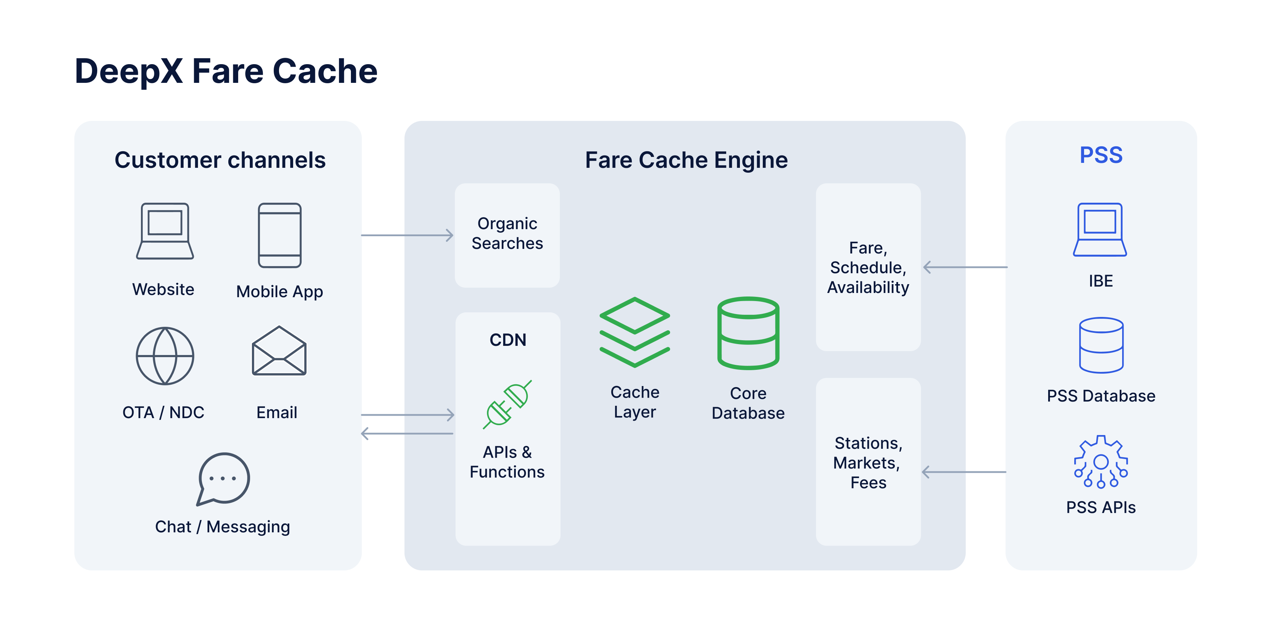Speed, accuracy, and user experience are critical to staying competitive in the aviation industry. One of our airline partners recently adopted a cloud-native fare caching solution built on AWS. The results: faster flight searches, lower infrastructure load, and improved customer satisfaction.
In this case study, we explore how fare caching works, the benefits it offers, best practices for implementation, and real-world use cases.
What is Fare Cache?
Fare caching is the process of temporarily storing flight prices and seat availability in a high-speed memory layer (cache) to improve the performance of flight searches.
Instead of querying the airline's reservation system (or PSS) in real time for each user search, a cached layer delivers results instantly. This reduces latency and system load, while still maintaining data accuracy through frequent updates.

Why Fare Cache matters?
Faster flight search results By pulling results from a local cache rather than querying the central system, websites can return search results in milliseconds. This significantly improves the user experience, especially on mobile devices or during peak travel seasons.
Lower system load
The cache reduces the number of queries sent to the reservation system or global distribution systems (GDS). This minimizes the risk of system bottlenecks and ensures continued availability during traffic spikes.
Enhanced reliability
A properly managed Fare Cache creates a buffer between real-time systems and unpredictable web traffic. If the underlying systems go down, cached data can still provide accurate pricing for a period of time.
Cost optimization
Reducing reliance on real-time systems also means fewer infrastructure resources are needed to handle peak demand. This translates to look-to-book cost savings, particularly in cloud environments where scaling impacts budget.
Best practices for an effective Fare Cache
Tune your caching duration
The key is to find the right balance between data freshness and performance. Short cache durations offer up-to-date fares but increase system load. Longer durations reduce load but may risk showing outdated fares. Many airlines opt for dynamic update intervals (ranging from minutes to hours) based on route popularity and booking volume.
Use smart invalidation rules
Implement automatic invalidation of outdated data. This can be done with TTL (time-to-live) settings or event-based triggers (e.g., when a fare changes or availability updates).
Employ multi-layer caching
Divide your cache into multiple layers:
- L1 (hot cache) for the most popular routes and dates
- L2 (cold cache) for less frequent searches
This layered approach ensures fast response times while minimizing storage costs and system strain.
Predictive caching
Use historical search data to pre-fetch and store prices for high-demand routes, particularly during holiday periods or sales events.
Monitor cache effectiveness
Track cache hit/miss ratios and analyze performance metrics regularly. This helps to identify outdated data issues or opportunities to fine-tune caching rules.
Real-world applications for Fare Cache
Fast and scalable flight searches
Flight search speed is critical. Our AWS-based Fare Cache implementation enabled our partner to serve millions of requests per day with sub-second response times.
Supplying fare data to external platforms
Fare Cache can also power third-party tools:
- Metasearch engines
- Travel agencies
- AI assistants like ChatGPT or Gemini
This creates additional booking channels and maintains fare accuracy.
Operational stability and cost savings
Reducing the load on the core reservation system improves reliability. It also lowers the need for additional infrastructure, especially during promotional events or seasonal peaks.
Conclusion
Fare Cache is providing a faster and more reliable experience to the end-users. It is also reducing backend costs, resulting from the clear competitive advantages that caching solutions can deliver for airlines.
Our cloud-based implementation with AWS is already delivering measurable results for our airline clients, and we continue to refine our strategies for even greater performance.

 Elevating Our Brand: DGITAL's Next Chapter
Elevating Our Brand: DGITAL's Next Chapter